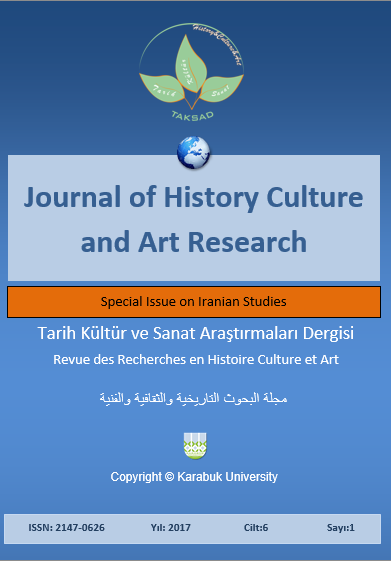Analytical and Semantic Survey of the Symbols of the Tree of Life and Goat in Jiroft
DOI:
https://doi.org/10.7596/taksad.v6i1.767Keywords:
Goat, Jiroft, Tree of Life, Semantics, Symbol, Ancient motifs, Persian vessels.Abstract
This research is an attempt for pictorial study and semantic analysis of the symbols of the tree of life and goat in Jiroft that is organized by citing pictorial samples and considering mythical beliefs. An extensive pattern of the symbol of the tree of life had its most presence alongside the symbol of the goat throughout history and studying the statistical population of this research, the vessels of Jiroft, we can see the continuity in following the common themes in their creation. This study, in terms of the nature and method, is descriptive-analytical and it tried to perform, logically and historically, an analytical and semantic survey of the mentioned patterns. The results of studied samples indicate that life-giving force, eternal life, desire for heaven, blessing and fertility are the most important concepts of semantics and are of the logical reasons of the connection between these two in Jiroft. Presenting two goats around the tree can be a symbol of the earth, giving birth, winter, agility and a symbol of fertility. Also, the tree of life in Jiroft is taken from the archetype pattern of the cosmic tree, that in terms of public, it had been sanctified and honored as a ritualistic value and with presenting a goat next to it, will contain supernatural semantic connotations. Even though all existing motifs of goats and tree on these works do not seem symbolic, the study of two-way communication between the mentioned symbols helps us greatly to understand their singular nature.
References
Abdollahian, Mahnaz (2008). The Concepts of the Mithras and Moon in Pre-Historical Potteries. Arts Quarterly, Issue 2.
Bahar, Mehrdad (1997). From the Myth to the History, First Edition. Tehran: Cheshmeh Publication.
Basiri, Mohammad Sadegh & Sarfi, Mohammad Reza (2005). A Look at the Mythical Content of the Figures of the Tree in Jiroft’s Civilization. Iranian Studies, Research Center for Iranian Culture and Languages, Shahid Bahonar University of Kerman, Year 4, Issue. 8.
Chevalier, Jean & Gerberan, Alan (2003). Culture of the Symbols, Fourth Edition, Translated by Sodabeh Fazaeli. Tehran: Jeihon Publication.
Cook, Roger (2008). Tree of Life, Translated by Susan Salimzadeh and Helena Maryam Ghaemi. Tehran: Jeihon Publication.
Dadvar, Abulqasem & Mobini, Mahtab (2009). Hybrid Creatures in the Art of Ancient Iran. Tehran: University of Al-Zahra.
Dubocour, Monique (1994). The Living Secrets of Life, Translated by Jalal Sattari. Tehran: Markaz Publication.
Eliade, Mircea (1995). Myth, Dream, Mystery, Translated by Roya Monajjem. Tehran: Fekre Rooz Publication.
Eliade, Mircea (1997). A Treatise on the History of Religions, Translated by Jalal Sattari, Second Edition. Tehran: Soroush Publication.
Gershevitch, Ilya (2006). The History of Iran in Achaemenid Period (From the History Collection of Cambridge), Translated by Morteza Saqebfar. Tehran: Jami Publication.
Ghani Nezhad, Fahima (2000). Legend and Magic. Monthly Book of Art. Issues 27 and 28.
Godard, Andre (1998). Art of Iran, Translated by Behrouz Habibi. Tehran: Shahid Beheshti University.
Green, Wilfred et al. (1997). The Foundations of Literary Criticism, Translated by Farzaneh Zaheri. Tehran: Niloofar Publication.
Hall, James (2001). Graphic Culture of Symbols in the Art of East and West, Translated by Roqayeh Behzadi. Tehran: Farhang Publication.
Hynls, John Russell (2000). Recognition of Iranian Mythology, Translated by Jaleh Amozegar and Ahmad Tafazoli, Sixth Edition, Tehran: Cheshmeh Publication.
Ismailpour, Abulqasem (1999). The Myth of Symbolic Expression. Tehran: Soroush Publication.
Majidzadeh, Yusef (2003). Jiroft, the Most Ancient Civilization of the East. Tehran: Cultural Heritage Organization Publishing.
Malakzadeh Bayani, Malakeh (1996). The History of Seal in Iran. Tehran: Yazdan Publication.
Mazda Pour, Katayoun (2003). Zoroastrians. Tehran: Cultural Research Bureau.
Negahban, Ezzatollah (1989). Metal Vessels of Marlik. Tehran: Cultural Heritage Organization.
Pakbaz, Roein (2000). Iranian Paintings from Ancient Times until Today. Tehran: Zarrin and Simin Publication.
Porada, Edith (2007). The Art of Ancient Iran, Translated by Yousef Majidzadeh, Third Edition. Tehran: University of Tehran.
Pour Khaleghi Chatrodi, Mahdokht (2001). The Tree of Life and its Symbolic and Cultural Values in Beliefs, Iranian Studies, Research Center for Iranian Culture and Languages, Shahid Bahonar University of Kerman, Year 1.Issue. 1.
Reichelt, Hans (2004). An Approach to Gathas of Zarathustra and New Avestan Texts, Translated by Jalil Doostkhah. Tehran: Ghoghnous Publication.
Sheikhha, Nazmaryam & Rahnama, Rashid (2013). Motion in Pictorial-Motion Graphics. Tehran: Aban.
Downloads
Published
How to Cite
Issue
Section
License
All papers licensed under Creative Commons 4.0 CC-BY.- Share — copy and redistribute the material in any medium or format
- Adapt — remix, transform, and build upon the material for any purpose, even commercially.
Under the following terms:
Attribution — You must give appropriate credit, provide a link to the license, and indicate if changes were made. You may do so in any reasonable manner, but not in any way that suggests the licensor endorses you or your use.
- No additional restrictions — You may not apply legal terms or technological measures that legally restrict others from doing anything the license permits.







